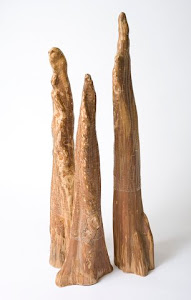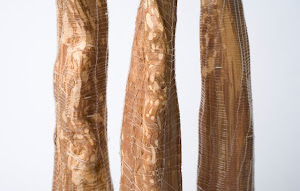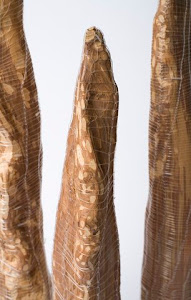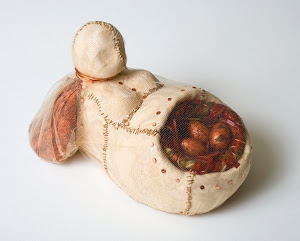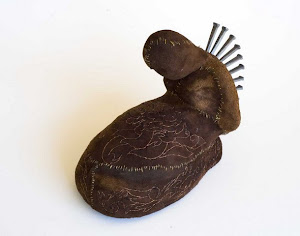


The November/December 2007 issue of FiberArts magazine features their annual showcase of student work in fiber, which is based on refinement, consistency, and presentation. This show represents what is being created in American and Canandian colleges and universities today. FiberArts advocacy of emerging artists is important to share with the world, because (despite my last blog) means that the art community is taking especial notice to new artists and their new perspectives. By taking notice, the art world is essentially taking a deep breath and allowing for freshness. Check out the full listings of the student work at http://www.fiberarts.com/back_issues/11_07/student_showcase.asp or in the current edition of FiberArts magazine. Here are some ways to get involved in sharing your fiber art with the community:
THE SQUARE INCH GALLERY. Call for artists. No deadline. Small works gallery to sell artwork tailor-made for apartments, located on the upper west side of Manhattan. All art is to be 36" or smaller in any dimension (not including frame). Monthly dues $42 for those artists able to drop off art on designated day, and $50 for those artists who are shipping their art to the gallery. Up to 10 works per artist may be exhibited each month. Each artist will have their work on view every month. The artist has sole discretion as to what work they exhibit. Each artist handles sales directly (through Paypal). There is no commission taken by the gallery. While every precaution will be taken to keep the art protected, artists must understand that they exhibit at their own risk. For information, Liz Afif, Square Inch Gallery, 215 W. 101st St. #3J, New York, NY 10025. (914) 434-1250 (cell); liz@squareinchgallery.com; squareinchgallery.com.
PENLAND SCHOOL OF CRAFTS 2008 PRINT AND LETTERPRESS RESIDENCIES. Call for applications. Deadline October 30. Residencies designed for 4–8 artists (depending on the length of stay) who would like to work with a master printmaker or letterpress printer for either two weeks or one month. One month residencies run January 1 through 31; two-week residencies run either January 1 through 14 or January 17 through 31. This residency will provide artists with little or no printing experience a chance to work in Penland’s new facilities with master printers to create editions of broadsides, prints, or small publications. Through the program, Penland hopes to foster new connections and cross-pollination between different media and processes, to provide professional opportunities for individual or collaborating artists, and to promote awareness in the fields of letterpress and printmaking. Penland will provide studio and housing expenses; artists supply their own materials and food and cover travel expenses. Applications can be downloaded at http://www.penland.org/.
PROVIDENCE ART WINDOWS PROJECT. Call for proposals. Juried. Deadline October 18 (postmark). Art will be installed by selected artists in windows downtown Providence, RI. Work may be pre-existing or site specific; 2-D or 3-D. Two rounds of installations will be included; the first opening will be November 15 and the second will be March 20, 2008. Small stipend available. To enter, send ten JPEGs on disk, proposal, resume, and SASE to: 205 Kenyon Ave., E. Greenwich, RI, 02818. No e-mail entries. Information: Liz Keithline, (401) 578-4313; keithlineri@cox.net.
QUILT VISIONS 2008. Call for entries. Cash awards. Catalog. Entry fee. Juried exhibit. Deadline January 12, 2008. Artists are invited to enter up to three quilts (a set of coordinated pieces may be considered one work or entry). An entry must be composed of three layers, two layers of cloth filled with “batting material” and held together by “stitched” design. Quilts may be embellished with materials other than cloth. Each quilt must have a sleeve securely attached to the back of the quilt. Entries must have been completed on or after January 1, 2006. A maximum of one quilt per artist will be selected for exhibit. All submissions must include digital images in JPEG format on a CD, which will not be returned. Jurors will select the quilts from images of work for consideration. Preliminary selection will be finalized when the quilts are received for photography. To submit entries, QV 2008 Jurying Committee, 2825 Dewey Rd. Ste. 100, San Diego, CA 92106. For more information, (619) 546-4872; visions@quiltvisions.org ; quiltvisions.org/visions/index.html.
FIBER CELEBRATION 2008. Call for entries. Deadline January 31, 2008.International juried exhibit of fiber arts. Held at the Lincoln Center in Fort Collins, CO, May 16–June 24, 2008. For information, contact Margie Holley (970) 593-0929; theholleys@holleys.net; www.fortnet.org/NCWG.
A TEAR IN THE FABRIC: THE CONCEPTUALLY DRIVEN QUILT. Call for entries. Deadline February 1, 2008. Open to artists who are residents of U.S. Artist can submit up to three works for consideration. Quilts must be no larger than 90" x 90". Work must be original. Please include a brief explanation of each quilt with image. This show California Polytechnic State University aims to reveal the layered nature of quiltmaking. Many times there is a social and political message that underlies the beauty of the piece and operates as a covert resistance or challenge to the social constructs of the time. Alternately, a quilt might contain a playful double entendre or ambiguity that lends itself to more than one interpretation that causes one to pause and adjust one’s thinking patterns. Through the display of these quilts, the exhibition hopes to inspire viewers to pause a little longer, dig a little deeper, and look for meaning that may lie beneath the surface of public discourse, first glances, and initial judgments. Send your digital or slide images to: Carolyn Mazloomi (independent curator), 5481 Oldgate Dr., West Chester, OH 45069. (513) 755-3414; CLM@carolynlmazloomi.com.
There are always ways to share your art and perspective...check around your community for flyers, internet shows, and galleries/museums/and school galleries in your area. If you want your work out there, you can always find a way!
PHOTOS:
1. Jung Yeon Choi, Uninvited (with detail), 2007; organza, wire, paper; dyed, sewn; 15' x 20'. MFA Fibers, Cranbrook Academy of Art, Bloomfield Hills, Michigan. Photo by Tim Thayer.
2. Cheryl Lommatsch, Twinned Creature I, 2006; chicken wire, shell, hardware remnants, paper pulp, beeswax, linen thread. 6" x 3" x 2". MFA, Fibers, California State University, Long Beach, California.
3. Kari Scott, You, Too, Can Be Fat Like Me, 2007; mercerized cotton; machine and hand-knit, painted, dyed. BFA Craft/Material Studies, Virginia Commonwealth University, Richmond, Virginia.





